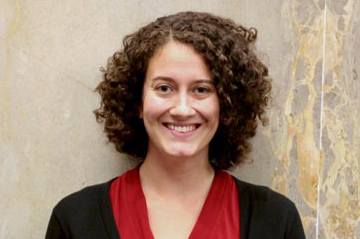My name is Alena Stern, and I worked as an AidData research assistant during my four years at the College of William and Mary. During my time as a research assistant, I was given the opportunity to contribute to some amazing AidData projects. I worked on the Mapping for Results Initiative (M4R), AidData's pilot geocoding partnership with the World Bank. Later, I traveled with an AidData team to Uganda to implement a randomized control trial testing how to most effectively engage citizens to provide crowdsourced SMS feedback on development projects. When AidData received a 5-year, $25 million grant to work with USAID through the Higher Education Solutions Network, the AidData staff asked me to give the presentation on the AidData Center for Development Policy at the network launch event- making AidData the only institution within the network to ask a student to present. I think that this speaks to the remarkable way that AidData leverages the capacity and creativity of their student research assistants, placing them at the center of AidData's efforts to produce cutting-edge data, analytic tools, and research.
I was truly honored to introduce the AidData Center for Development Policy to the world and am tremendously excited for what the future holds for AidData.
The presentation I gave follows below
https://youtu.be/Vseq5l8vdv4
The AidData partnership was created with a clear mission: to capture the entire universe of aid at the project-level in a single database. Over the last ten years, William & Mary, BYU, and Development Gateway have made huge progress toward this goal: the AidData.org web portal currently tracks 1 million projects and nearly $5.5 trillion in global development finance. However, until very recently, the AidData team still couldn’t answer a fundamental question: Where are all of these projects located on the ground?
Owen Barder, a Senior Fellow at the Center for Global Development, said, “AidData allows citizens of countries that give and receive aid to better understand where the funding is going. Geocoding will enable the next step: linking that information to results on the ground.” Owen is not the only one to recognize this necessary next step. Many development practitioners and scholars have identified the need for the sub-national geographic coding of aid information.
However, the skeptics (and there were many) said that the information was either not available or too costly to generate.
Undeterred by the naysayers, AidData and the World Bank launched the Mapping for Results initiative in the summer of 2010. I was a part of a team of AidData interns that achieved something truly remarkable: we geo-coded the World Bank's entire active project portfolio: 2,500 projects in 30,000 locations across 144 countries.
The Mapping for Results initiative had immediate and far-reaching impacts. One of the very first maps that we produced demonstrated that, while poverty is most concentrated in the Kenya’s North, aid projects are clustered in the South. This map prompted serious discussions within the World Bank about how they were targeting aid.
Simon Mizrahi, Manager of AfDB’s Quality Assurance and Results Department, explained, “This is a critical step toward being able to ask the right questions about whether aid is going to the right places and what impact it has.”
But this map only included data from 2 of the 60+ bilateral and multilateral aid agencies that are active in Kenya.
Effective coordination requires that each donor knows what every other donor is doing and where. In the summer of 2011, the Climate Change and African Political Stability (CCAPS) program at UT-Austin and AidData proved that it is possible to geocode the entire universe of aid projects in Malawi. We did this in Malawi and it enabled donors to more effectively coordinate with each other and the government to reduce duplication and other sources of inefficiency.
Ken Lipenga, the Minister of Finance of Malawi, applauded the map saying, "Being able to see in a map all the donor funded activities has transformed the way we think about development and positively helped our own planning effort."
In the summer of 2011, I was part of an AidData-UNICEF Uganda research team that tested how to most effectively engage citizens to provide crowdsourced feedback using their cell phones.
Geo-coded aid information makes it possible to tag this citizen feedback to specific donor-funded projects, creating a “Yelp” for development finance. This will help to close the feedback loop between donors and their intended beneficiaries.
These are just a few of the ways in which geospatial data can change the way the development community tracks aid distribution and impact. With support from USAID AidData will be able to extend geocoding of all activities within the Aid Management Platforms of 15 countries, build local capacity among local universities, Government, CSOs, and Donor Partners, and develop cutting-edge geospatial analysis tools and research methods.
USAID recognizes the power of geo-coded information. Thanks to their vision and support, the AidData Center for Development Policy will help the global community to take a major step towards making access to actionable geocoded aid information a right for all citizens, not a privilege for few.
